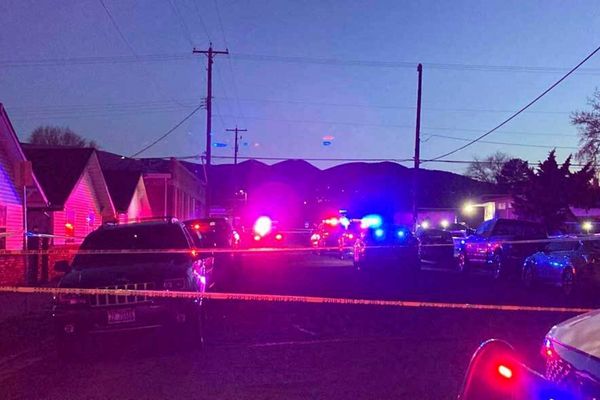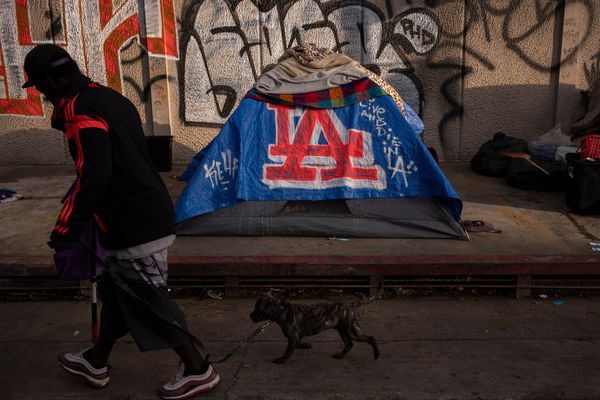
We’re nearly two hours into our conversation when Morgan Khan starts to cry. I have just mentioned that for decades now, the UK charts have been filled with the children of Street Sounds, the dance music compilation series he began 40 years ago. “It’s true,” he says, when he has composed himself. “I’m balding, with a pot belly and a small dick. That’s me being objective. But what you said is true.”
Without ever writing a song, without ever fronting a group, Khan changed the face of British music. He was one of the first cheerleaders for Britfunk, the first to bring electro and hip-hop to the UK, and one of the pioneers of house. Every root of the dance music that has blossomed in mainstream pop grew in the UK thanks to Khan transplanting it from the US.
How far ahead of the curve was he? He licensed the first rap smash, Sugarhill Gang’s Rapper’s Delight, to release in the UK. He was the first person to bring Dr Dre over, as part of the World Class Wreckin’ Cru, to play Khan’s 1986 UK Fresh show. When Mory Kanté’s Yeke Yeke became the first African hit to break in Europe in 1987, Khan had released it on Street Sounds New Africa two years earlier.

In 1982, Khan – then 23 – launched Street Sounds, a compilation series that democratised the dance music underground. Suddenly, tracks that had been available only on import in specialist shops, bought by DJs and serious clubbers, were available to all. For the price of one import 12-inch, you could get 12 tracks on an album. Street Sounds had its own section in the high street music chain Our Price; I vividly recall the albums being loaned around by kids at my school in Slough.
“What was being released in the UK was palatable, watered-down soul,” Khan says of the early 1980s. “It wasn’t street. Everything that was happening in the clubs was on import, and that was the idea that sparked it. Buying imports was costing me half my weekly salary. I thought: these records are never going to see the light of day in Europe. Why don’t I go to the US – to the labels, producers and artists – and let me license them for Europe?
“Actually, 90% of them didn’t even know where Europe was. They just wanted to sell in the tristate area [New York, New Jersey, Connecticut] and California. For them, getting an advance for a territory they would never sell to anyway … bonus! No one had approached them before. The majors hadn’t caught on to Black music, street music – they jumped on later. When they saw what we were doing, it became harder for me, because they would hand out million-pound cheques. But before that they didn’t realise the sales potential.”
Khan was born in Hong Kong to Anglo-Indian parents. His father was an airline pilot who later lost his job for diamond smuggling, and his family came to the UK when he was nine. He entered the music business – not his parents’ dream for him – in the late 70s, first as a DJ. “They loved my energy,” he tells me. “I’d put on a record, leave the booth and come out and dance with the crowd, then run back in.” Next he was a post boy at the Pye label – at one point, without a home, he spent several months living in their offices – before working in their promotions department on disco releases. “The treatment of dance music was the epitome of racism,” he says. “There was a racist attitude to Black music: it wasn’t ‘serious’ music.” The N-word, he says, was used offhandedly around the industry. “It was just standard vocabulary. It was inbred into the system that you could talk like that, act like that, be like that.”
But it was Pye that first sent Khan to New York, where he did the deal with Joe Robinson of Sugar Hill Records to release Rapper’s Delight in the UK. “After the deal was done, Robinson handed me a bundle of notes and said, ‘Khan, buy some fucking clothes. You’re representing me now.’ That night a gift arrived at my hotel room.” He pauses for effect. “She was beautiful.” He pauses again. “All we did was watch TV and eat cheesecake. I was 21.”

From Pye, he set up his own imprint, R&B Records, which introduced the pioneering funk band Imagination. He left that because he felt his backers weren’t paying him enough, and with the support of Maurice Oberstein, who ran the UK arm of CBS, he set up Street Sounds for US tracks and Street Wave for his own artists.
“He took that music into the suburbs and the small towns, so it was everywhere,” says the DJ Greg Wilson, who adds that Khan was “priming people” for the late 80s rave scene. “A lot of those people had come out of listening to the Street Sounds Electro compilations. Electro was raw – it really swept everything away that went before and began a new world for dance and pop.” It was, Khan and Wilson agree, dance music’s punk moment: nothing would be the same again.
Khan’s A&R process for the compilations was simple. First, he would go to clubs: “You’ll see the records that, within a bar, had people not just dancing but getting down.” Second, he would go to New York. “I was flying to New York most Fridays and coming back on Mondays. I was collecting the quarter-inch master tape. There were no mobile phones. There was no digital file. I would go see some labels, fly back again. Cut the record on a Monday, have a test pressing by Wednesday because we were doing such volume. We’d be in production for Friday.”
Promotion was from the ground up. “I used the pirates and the club DJs. All these little pirate stations around the UK were starting to play Black music; the legal stations wouldn’t touch it. Each month, 3,000 vinyls went out, maybe more. If the top DJ in a town plays it, other DJs hear it and buy it and play it – you get it to the kingpin in each area, and they are effectively your promotions department.”
The first Street Sounds compilation sold around 10,000 copies, Khan says, but they soon started flying off the shelves, aided by the switch to text- and graphic-based designs for the Electro series, designed by John Carver and reminiscent of Neville Brody’s work for The Face, which gave the records a sleek modernity that the first covers – with graffiti-style writing – didn’t have. Suddenly, new names were being talked about in schools around the UK: Newcleus, Rammellzee, Cybotron, Run DMC. By the sixth Electro compilation in 1984 the direction of travel was clear: it featured both sides of the Roxanne wars between the Real Roxanne and Roxanne Shante, as well as Whodini and Doug E Fresh (credited as Dougy Fresh). Hip-hop was the new thing, and Khan was already on top of it.

He was soon overreaching, though. His plans to make his organisation the British Motown (“Detroit comes to West Acton!” as one ad campaign enthusiastically put it) foundered on the fact that while the Street Sounds albums were selling – the series racked up 57 chart entries in five years – he was less successful hitting the singles chart with artists he signed directly to Street Wave. The UK Fresh festival at Wembley Arena in 1986 – by a huge distance, the biggest hip-hop show in the UK to that point, and for several years after – was a hit, but his Street Scene magazine, centred on Black music, emptied the coffers.
Still he persisted, and in a remarkable comeback he set up a new label, Westside, in 1987, and won the licenses to release the Chicago house labels Trax and DJ International in the UK, only to be gazumped by those with deeper pockets. “We had done the hard work and then the artists started signing major deals. What chance did I have? Pete Tong was flying off to Chicago with a blank chequebook: how do you compete?”
Street Sounds still exists – it’s an internet radio station – and Khan wants to get back to releasing compilations of the most exciting underground dance music from around the world again, maybe four a year. He’s angry that others are celebrated for bringing hip-hop and house to the UK mainstream: “People credit Paul Oakenfold and Pete Tong and it fucks me off. People have tried to change the history and it hurts me.” Wilson thinks that’s because the collapse of Street Scene left others out of pocket and resentful of Khan for their losses, and because a new generation came to dance music in the late 1980s and simply assumed Ibiza in 1987 was the year zero, with no appreciation of what had come before.
“There’s nothing about him in the books, even though he’s a central figure in the history of British dance culture,” Wilson says. “He was young, he was brave, and he was prepared to put his reputation on the line.” He’s older now, but Morgan Khan remains indefatigable, and convinced talent will surface through the dross – and that he will find it next. “I’m appalled by bedroom DJs who put out these shit beats and everyone thinks they can make music,” he says, before smiling. “But the next Prince is out there.”
Morgan Khan on his favourite discoveries
Sugarhill Gang – Rapper’s Delight (1979)
“Credited for introducing hip-hip to the mainstream, even though it was preceded by the Fatback Band’s King Tim III (Personality Jock) by a few months. Sylvia Robinson, the producer, wanted to capture on vinyl the phenomenon of rappers performing live at block parties in the Bronx – its significance still can not be overestimated.”

Imagination – Body Talk (1981)
“My first own label release, on R&B Records. Imagination dared to be different with their signature sound and overtly camp stage persona; groups like Imagination proved that Britfunk and soul could take on the Americans, and laid the foundations for the next generation of groups like Soul II Soul.”
Hashim – Al-Naafiysh (The Soul) (1983)
“A new tour de force would soon empower the music of the street, and Al-Naafiysh (The Soul) epitomised this new music: electro, the driving force behind the emergence of B-boy culture, breakdancing, graffiti and the boom box.”
Cheryl Lynn – Encore (1983)
“CBS UK had decided not to release this track as a single, despite the pedigree of the artist, and that the song was written and produced by the highly successful Jimmy Jam and Terry Lewis. They said they did not see it as a hit, or [an] artist worth promoting – you can deduce why. I persuaded them to license me the track and through our very capable street promotions network, we took Encore into the Top 75. I then received a call: it was suggested by certain powers to halt the chart progress so as not to further embarrass CBS UK to their American bosses.”
Rose Royce – Magic Touch (1984)
“Rose Royce had substantial hits in the 70s with lead singer Gwen Dickey, including Car Wash and Wishing on a Star. Unfortunately, Gwen leaving the band coincided with a change in the style of music being played in clubs. Magic Touch did nothing in the US, whereas in the UK, Street Wave had a huge record – the track has become a staple anthem at soul weekenders ever since.”
Joe Smooth – Promised Land (1987)
“House music was born in Chicago, and Promised Land was the quintessence of the genre at its birth. The soulful vocals of Anthony Thomas over the straight four-to-the-floor bass drum became the template for pop music today.”
Humanoid – Stakker Humanoid (1988)
“The fact we produced, recorded and mixed this track at our studios in Ealing always gives me a sense of pride – we created one of the biggest records of the acid genre, and opened the door to the acid-jazz movement.”







